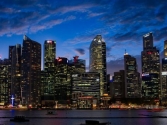Thought Leadership Centre
Most Read
1. Singapore urged to increase renewable grid interconnection investment 2. MTI and EMA seek feedback on energy legislation changes 3. Meralco plans micro-nuclear power plants for remote areas by 2028 4. Pressures mount for less desirable energy insurance placements in the region 5. India's renewable energy tender issuances reach record 69 GWResource Center
Awards
Oct
22
Oct
22
Oct
22
Event News
Event News
Thailand at the forefront of ASEAN's energy transition: A look ahead to Future Energy Asia
Co-Written / Partner
Co-hosted by industry leaders and supported by government officials, the Future Energy Asia Exhibition and Summit aims to accelerate the region's journey towards net-zero emissions.
Co-Written / Partner
Thailand at the forefront of ASEAN's energy transition: A look ahead to Future Energy Asia
Co-hosted by industry leaders and supported by government officials, the Future Energy Asia Exhibition and Summit aims to accelerate the region's journey towards net-zero emissions.
Videos
Partner Sites
Join the community
Thought Leadership Centre
Most Read
1. Singapore urged to increase renewable grid interconnection investment 2. MTI and EMA seek feedback on energy legislation changes 3. Meralco plans micro-nuclear power plants for remote areas by 2028 4. Pressures mount for less desirable energy insurance placements in the region 5. India's renewable energy tender issuances reach record 69 GWAwards
Oct
22
Oct
22
Oct
22

 Advertise
Advertise




















Commentary
Australian energy may be more useful abroad than at home
Australian energy may be more useful abroad than at home
A comprehensive guide to energy management in process industries
Direct-Drive Wind Turbines: Can the Chinese Keep Their Lead?
Australian energy may be more useful abroad than at home
A Lifecycle Approach to Energy Management in the Process Industries
Hydropower in Asia - Let the rivers run
Why Nuclear is one step back, but two steps forward
Banks need to beware of sustainability risks in the power sector
Changing Insurance Conditions for the Operational Power Sector challenge operators
Will Japan beat a full retreat from Nuclear?
Greening Malaysia’s shipping sector : A call for action
The new paradigm for utility information security: assume your security system has already been breached
The evolution of the energy consumer
How to improve the efficiency of existing coal-fired power plants
China: The Global Wind Leader
Smart Grids for the future – but what about today?
Here comes the sun: Where to from here for the Chinese Solar industry?